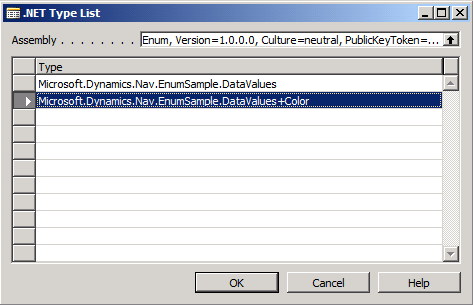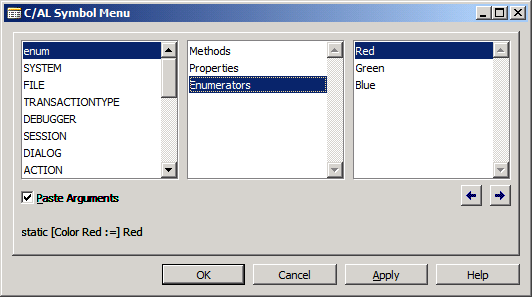In the .NET Framework, an enumeration typically represents constant values as symbolic or literal names. For example, if you have the type Color, then instead of using the values 0, 1, and 2, you can use Red, Green, and Blue. The following is a C# code example for the Color enumeration.
| C# |  Copy Code Copy Code |
|---|---|
namespace Microsoft.Dynamics.Nav.EnumSample
{
public class DataValues
{
public enum Color
{
Red,
Green,
Blue,
}
}
}
| |
.NET Framework interoperability supports symbolic names in enumerations. In C/AL code, enumerations are handled like static fields on the .NET Framework type.
Creating and Calling DotNet Variables for Enumerations in C/AL
You create DotNet variables for enumerations similar to other .NET Framework types. When you create a DotNet variable for an enumeration in the development environment, the enumeration name in the .NET Type List is preceded by a plus sign. The following illustration shows the .NET Type List for the enumeration in the previous code example.

To call an enumeration from C/AL code, you can use the C/AL Symbol Menu, which displays all the values for the enumeration. The following illustration shows an example in the C/AL Symbol Menu.

The following C/AL code assigns the Red value to the Color enumeration.
 Copy Code Copy Code | |
|---|---|
Color := Color.Red; | |
After the value is assigned, you can use the enumeration value in the C/AL code similar to a C/AL option data type. You must reference .NET Framework enumerations by using the DotNet variables that define them.
Example
In the following C/AL code example, the DotNet variable EnumTarget defines a method called MyMethod that has an enumeration type parameter. In the example, the MyMethod method is invoked by using the Color enumeration that is discussed in the previous sections of this topic.
 Copy Code Copy Code | |
|---|---|
EnumTarget.MyMethod(Color.Red); EnumTarget.MyMethod(0); // Assumes that the enumeration value Red has the numerical value of 0. | |
The common language runtime automatically maps the value 0 to the correct enumeration value of Red.




